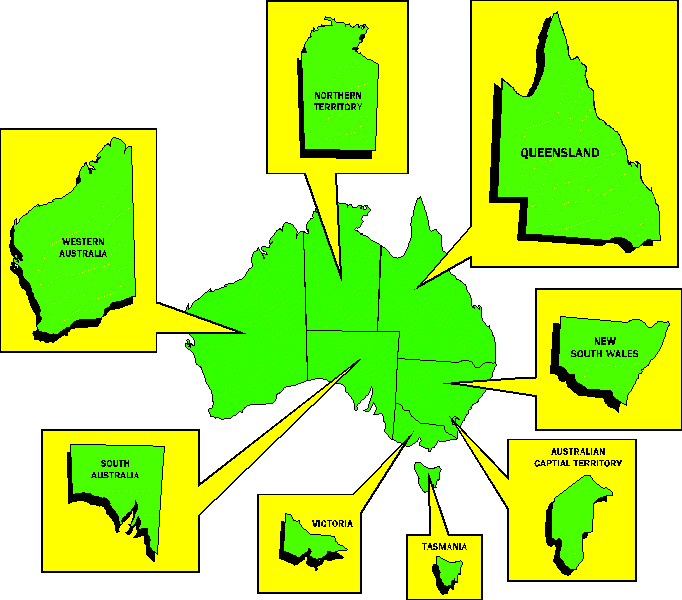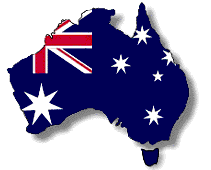The States and Territories of Australia


![]() Deutschsprachige
Texte sind durch die deutsche Flagge markiert.
Deutschsprachige
Texte sind durch die deutsche Flagge markiert.


The 1996 census showed there are 17,892,423 people in Australia on census night, an increase of 6.2% from the 1991 figures.
The population is ageing with an average age of 34 years, with 12.1% aged 65 years and over.
Of all people, 73.9% were Australian born and of those born elsewhere, 36.2% came from the United Kingdom. New Zealand or Ireland, with the majority of the remainder coming from Italy, Vietnam, Greece, China and Germany. People of aboriginal descent increased by a third from 265,458 in 1991 to 352,970. Of these, over half, 55.8%,were counted in New South Wales and Queensland. In the Northern Territory the indigenous proportion of the population was 23.7%.
The average wage for people 15 years and over was $292.00, up from $268.00 in 1991.
Around 40% of the occupied dwellings in Australia are owned by their occupants with 25.5% being purchased and 28.7% rented.
There are more women (50.5%) than men (49.5%) in all areas except the Northern Territory.
These figures were obtained from a news-sheet issued from the Bureau of Statistics home page. (See Below)
The figures below show all persons living in the Australian States and Territories at census time in 1996. There is also a projected list from the Bureau of Statistics for the year 2050.
Bureau of
Statistics Home Page
THE GEOGRAPHY OF
AUSTRALIA
Australia is the earth's largest island and
its smallest continent.
The mainland comprises 5 states and 2
territories. The sixth state, Tasmania, is 200
kilometres south of Victoria and separated from
the mainland by Bass Strait.
To the east, Norfolk and Lord Howe Islands are
governed from Australia, as is the Antarctic
holding based around Mawson.
It is the driest continent on earth with around
1/3rd considered desert. It is approximately
3,700 km. long (north to south) and 4,000
kilometres wide.
The mainland section is roughly divided in the
east by the Great Dividing Range which lies
inland from the eastern seaboard and runs from
the Cape York Peninsula in Queensland to
Melbourne in Victoria. Included in the range is
Australia's highest peak, Mount Kosciusko (2,229
metres) near the New South Wales-Victoria border
in the snow capped alpine region of the Great
Dividing Range.
West of the dividing range the land is mainly
flat with a few low ranges including the Flinders
Ranges in South Australia and the MacDonnell
Ranges near Alice Springs.
The centre of the continent is mainly desert and
sparsely populated. Around 80% of the Australian
population lives within the eastern seaboard or
the coastal fringes of the continent.
Massive salt lakes, often dry for long periods,
will be found in the mid-north of South Australia
and these are fed by a large river system which
carries water for hundreds of kilometres to fill
them. The largest of these, Lake Eyre (9,475 sq
km.), was filled this year (1994) for the first
time in over a decade. What water does not
evaporate from these lakes is fed into the
Central Australian Artesian Basin, a vast natural
underground series of aquifers from which
occasional springs bubble in the most remote
desert areas, and from which Alice Springs draws
its water supply.
The figures below show the area, coastline and border length of all Australian states and the islands off their shores.
External Territories are those remote from the mainland Australia and governed by it.
Some of the highest, lowest, oddest and interesting facts about Australia.
 Australien ist das einzige Land der Erde,
daß sich über einen ganzen Kontinent erstreckt.
Inklusive Tasmanien und vorgelagerter Inseln ist
Australien knapp 7.700.000 qkm groß. Dies entspricht
etwa der Fläche der USA ohne Alaska oder 20 mal der
Fläche Deutschlands. Flächenmäßig rangiert Australien
auf Platz 6 in der Welt. Die Küstenlinie Australiens
beträgt etwa 37.500 km. Australien ist wahrlich ein Land
der Superlative. Von West nach Ost (Perth - Sydney) sind
es etwa 4.000 km Luftlinie (von 114 Grad bis 153 Grad
östlicher Lange). Von Nord nach Süd (mit Tasmanien)
sind es etwa 3.700 km Luftlinie (von 10 Grad bis 44 Grad
südlicher Breite).
Australien ist das einzige Land der Erde,
daß sich über einen ganzen Kontinent erstreckt.
Inklusive Tasmanien und vorgelagerter Inseln ist
Australien knapp 7.700.000 qkm groß. Dies entspricht
etwa der Fläche der USA ohne Alaska oder 20 mal der
Fläche Deutschlands. Flächenmäßig rangiert Australien
auf Platz 6 in der Welt. Die Küstenlinie Australiens
beträgt etwa 37.500 km. Australien ist wahrlich ein Land
der Superlative. Von West nach Ost (Perth - Sydney) sind
es etwa 4.000 km Luftlinie (von 114 Grad bis 153 Grad
östlicher Lange). Von Nord nach Süd (mit Tasmanien)
sind es etwa 3.700 km Luftlinie (von 10 Grad bis 44 Grad
südlicher Breite).
Mit einer Bevölkerung von nur 18 Mio. ist Australien recht dünn besiedelt. Statistisch gesehen sind es nur knapp über 2 Einwohner pro qkm (Deutschland 218 Einwohner pro qkm). Knapp 60 % der 18 Mio. Einwohner leben in den fünf großen Städten: Sydney (4 Mio.), Melbourne (3 Mio.), Brisbane (1,2 Mio.), Perth (1,2 Mio.), Adelaide (1 Mio.). Weitere wichtige große Städte: Hobart, die Hauptstadt Tasmaniens (300.000), Canberra, die Bundeshauptstadt und einzige der genannten Städte, die nicht am Meer liegt (300.000). Der größte Teil der Bevölkerung Australiens lebt im fruchtbaren Südosten des Kontinents.
Australien ist ein ganzjähriges Reiseziel.
Der Norden ist tropisch. Beste Reisezeit ist die Trockenzeit (etwa April bis November). Während der Regenzeit fallen sehr ergiebige Niederschläge (Monsum), die temporär das Fortkommen unmöglich machen können. Während der Regenzeit und die erste Zeit danach ist das Baden im Meer in küstennahen Bereichen wegen der Würfelqualle (box jelly fish) nicht möglich (Lebensgefahr!). Der tropische Norden ist auch Verbreitungsgebiet der Salzwasserkrokodile. Vorsicht ist wegen der Salzwasserkrokodile ganzjährig vor allem in und an den Unterläufen der Flüße geboten.
Der Süden hat ausgeprägte Jahreszeiten. Die Sommer (Dezember bis Februar) sind im allgemeinen wärmer als in Deutschland. Oktober, November und März, April sind ebenfalls gute Reisezeiten für den Süden.
Das Zentrum ist sehr trocken. In den australieschen Sommermonaten kann es extrem heiß werden. In den Wintermonaten kann die Nachttemperatur unter den Gefrierpunkt fallen.
Internationale Airports: Sydney, Melbourne, Adelaide, Perth, Darwin, Brisbane, Cairns
Flugzeit: ca. 16 (Darwin) bis 21 Stunden, zzgl. Zwischenlandung, auf der Asienroute in Singapur, Bangkok oder Hongkong.
Australien wird von vielen renomierten Fluggesellschaften angeflogen: z.B. Qantas (die wichtigste Fluggesellschaft Australiens, täglich z.B. ab Frankfurt), Air New Zealand (Route über die USA), Singapore Airlines, Cathay Pacific. Je nach Saison kostet ein Flugticket mit einer dieser Airlines in der Touristenklasse zwischen DM 1.800,00 und DM 2.700,00.

